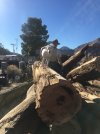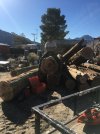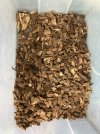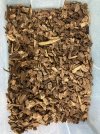Here's the question I pose for debate..... Orchid Bark is a must for substrate or Fir Bark. I read a review of a package of Orchid Bark and it said "Very little bark, had to pick it out. Mostly wood not Bark." Well most dimensional lumber is made from Douglas Fir, so what if I put a bunch of 2x4's in my chipper. Of course no sharp, large, or dangerous pieces...of course. Is there a difference in using the wood from the bark, especially when ALOT of orchid Bark bags contain chipped wood.
You are using an out of date browser. It may not display this or other websites correctly.
You should upgrade or use an alternative browser.
You should upgrade or use an alternative browser.
Douglas Fir wood chips
- Thread starter EppsDynasty
- Start date
That's a good question. I too have a chipper/shredder and I have used the end result product from mulberry branches for substrate. I assumed the chipped wood was ok.
I don't see why not. After all fir bark is mostly from Douglas fir.
Just make sure it's not treated lumber.
Just make sure it's not treated lumber.
I think he's questioning the use of the actual wood, instead of the barkI don't see why not. After all fir bark is mostly from Douglas fir.
Just make sure it's not treated lumber.
I thought it was asking about chipping up lumber also.
If it's unsalvageable for use in building, idk if I'd trust it as substrate. Even if it's not treated, there's no telling where it's been or what it's been in contact with.
If it's unsalvageable for use in building, idk if I'd trust it as substrate. Even if it's not treated, there's no telling where it's been or what it's been in contact with.
Yeah, I did get that. My thought was if the bark is fine, the wood would have to be.I think he's questioning the use of the actual wood, instead of the bark
Other than it coming from say a tear down that may have been at one time treated for termites, etc, what else is there that would make it unsafe? I'm drawing a blank trying to think of what else there would be.I thought it was asking about chipping up lumber also.
If it's unsalvageable for use in building, idk if I'd trust it as substrate. Even if it's not treated, there's no telling where it's been or what it's been in contact with.
I wouldn't use the wood. Orchid bark is fir "bark". Its not the wood. I don't know that the wood has the same "anti-rot" properties as the bark does.Here's the question I pose for debate..... Orchid Bark is a must for substrate or Fir Bark. I read a review of a package of Orchid Bark and it said "Very little bark, had to pick it out. Mostly wood not Bark." Well most dimensional lumber is made from Douglas Fir, so what if I put a bunch of 2x4's in my chipper. Of course no sharp, large, or dangerous pieces...of course. Is there a difference in using the wood from the bark, especially when ALOT of orchid Bark bags contain chipped wood.
And I agree with Jaizei about not knowing what the wood has been exposed to. I'm ignorant of how lumber at the store is treated, or if it is treated at all. I do believe it is "kiln dried", but I don't know if anything is sprayed on it at any point during the process. Someone please correct me if I'm wrong on any of this.
They used to treat it with arsenic or cyanide but I think that has been outlawed years ago and I think that was only wood that was going to be used outside in the elements, but not sure. But I have seen wood labeled as both treated and kiln dry so not sure what that's about, treated with what, it doesn't say.I wouldn't use the wood. Orchid bark is fir "bark". Its not the wood. I don't know that the wood has the same "anti-rot" properties as the bark does.
And I agree with Jaizei about not knowing what the wood has been exposed to. I'm ignorant of how lumber at the store is treated, or if it is treated at all. I do believe it is "kiln dried", but I don't know if anything is sprayed on it at any point during the process. Someone please correct me if I'm wrong on any of this.
I wouldn't think though the wood itself would be a problem as long as it's not treated with anything. New wood that is labeled may be the safe way to go, not repurposed wood.
I think you are thinking about "pressure treated lumber". That stuff is certainly treated, and as far as I know the arsenic has been banned for that use. What is in question, at least for me, is if "regular" lumber is sprayed or treated with any thing. Some people say not to burn it in a campfire because of fumes, so that makes me think there is something on it, but again, I will defer to anyone more knowledgable on the subject.They used to treat it with arsenic or cyanide but I think that has been outlawed years ago and I think that was only wood that was going to be used outside in the elements, but not sure. But I have seen wood labeled as both treated and kiln dry so not sure what that's about, treated with what, it doesn't say.
I wouldn't think though the wood itself would be a problem as long as it's not treated with anything. New wood that is labeled may be the safe way to go, not repurposed wood.
You might be right, I forgot about pressure treated.I think you are thinking about "pressure treated lumber". That stuff is certainly treated, and as far as I know the arsenic has been banned for that use. What is in question, at least for me, is if "regular" lumber is sprayed or treated with any thing. Some people say not to burn it in a campfire because of fumes, so that makes me think there is something on it, but again, I will defer to anyone more knowledgable on the subject.
OK step 1 Cut down tree...step 2 Haul tree to lumber mill...step 3 De bark the tree before it goes into the saws. Bark is terrible on saw blades, even commercial freaky big ones. I am pretty sure this is where Orchid Bark is actually obtained, ever heard of a Fir Bark Harvester...? I haven't...step 4 The "wet" trees go through the saw mill and are cut by different saw blades into different sized lumber. Wet trees are either trees that are still alive when cut, or trees that have fallen down due to death, wind or both. Once a tree has fallen it will only suck up water from the ground...step 5 Banding- The fresh cut lumber is banded for rail car or on the road trailers. Example When you go to the home store and buy lumber it's wet, thats water not anything sprayed. Could've been rained on traveling by train, or truck as well. Kiln dried wood is different, just as pressure treated is different. Now what most pressure treated wood is "Treated" with is copper.I think you are thinking about "pressure treated lumber". That stuff is certainly treated, and as far as I know the arsenic has been banned for that use. What is in question, at least for me, is if "regular" lumber is sprayed or treated with any thing. Some people say not to burn it in a campfire because of fumes, so that makes me think there is something on it, but again, I will defer to anyone more knowledgable on the subject.
I did not mean this as a smart *** answer. I was just wanting to allow everyone to understand it. Hope this helps.
Pondering on this question all day has got me wondering if drying it in the oven or outside during warmer days to "Kiln Dry" it. Whoa Whoa Whoa at low temps like 125 degrees Fahrenheit (52 celsius) to get rid of the oils. Maybe you wouldn't even need to.
Looking at this another way, what does the bark do for a tree? It protects that wood on the inside from pathogens and damage, right? It resists fungal, bacterial, and other threats because the wood inside isn't so resistant to those threats. This being the case, I don't think the wood inside the tree will perform the same as the ark on the outside.OK step 1 Cut down tree...step 2 Haul tree to lumber mill...step 3 De bark the tree before it goes into the saws. Bark is terrible on saw blades, even commercial freaky big ones. I am pretty sure this is where Orchid Bark is actually obtained, ever heard of a Fir Bark Harvester...? I haven't...step 4 The "wet" trees go through the saw mill and are cut by different saw blades into different sized lumber. Wet trees are either trees that are still alive when cut, or trees that have fallen down due to death, wind or both. Once a tree has fallen it will only suck up water from the ground...step 5 Banding- The fresh cut lumber is banded for rail car or on the road trailers. Example When you go to the home store and buy lumber it's wet, thats water not anything sprayed. Could've been rained on traveling by train, or truck as well. Kiln dried wood is different, just as pressure treated is different. Now what most pressure treated wood is "Treated" with is copper.
I did not mean this as a smart *** answer. I was just wanting to allow everyone to understand it. Hope this helps
Sorry but 90% wrong...... The bark protects the tree from pathogens as good as a surgical mask works for Covid. A perfect example is the Pine Bark Beetle that has killed more than 100 million trees in California alone. How bout Termites, their everywhere in the forest, inside of the trees past the bark. Certain things will be blocked out by the bark but it's not impenetrable. The bark of different trees serves different purposes. Pine trees have developed a "fire retardant" bark, wildfires are common in pine woodlands. Bark also is CRUCIAL for insulation. Birch bark is silver to reflect heat, they can not handle being hot. In the Pacific Northwest US is always wet. If the bark didn't keep out the rain the tree would rot or hold so much water it wouldn't be able to stand. Bark is also a crucial part of the way a tree transports nutrients. If you've ever cut up a tree with a chainsaw, or split wood you've seen rot, mold, dark areas of disease and all kinds of other faults in the wood. I do agree with you 100% on the fact that wood and bark are 2 different things. Bark acts different as well I agree, but is the "wood" so different it's unusable? (For Substrate). When the tree is de barked there is WOOD attached to the bark. It might be small in size but you can not deny it's there, so all of us have been using WOOD in small amounts already.Looking at this another way, what does the bark do for a tree? It protects that wood on the inside from pathogens and damage, right? It resists fungal, bacterial, and other threats because the wood inside isn't so resistant to those threats. This being the case, I don't think the wood inside the tree will perform the same as the ark on the outside.
Clearly this question threw the most knowledgeable people here for a loop.....I sincerely appreciate those that did participate and are going to in this DEBATE. We all look for ways to save $ but still provide our family members with an excellent life. This "wood" would be a big money saver for those who have the ability to chip or shred it. I have included some pictures of Cedar Trees that I cut up. I am no stranger to Logging and for that matter wood or bark either. I included these pics to show I speak from experience not just a hole in my head. Look at the wood, it's full of all kinds of stuff, faults. O yeah....Pine is harmful to tortoises.. but Orchid Bark is Pine Bark.



No, orchid bark is FIR bark. The difference between fir and pine is the essential oils in the tree. It is my understanding that pine oil is harmful, but fir oil is not. And the whole reason I started using fir bark is because years ago I learned that the fir bark did not cause impaction if the tortoise accidently eats it. I don't understand the difference between a piece of fir bark not causing impaction or a piece of pine bark, but that's what I've parroted all these years. . . the essential oils from pine, cedar, etc are harmful, but fir is not, and fir doesn't cause impaction.
FANTASTIC.......This is why I said to put it in the oven, to burn off any oils.No, orchid bark is FIR bark. The difference between fir and pine is the essential oils in the tree. It is my understanding that pine oil is harmful, but fir oil is not. And the whole reason I started using fir bark is because years ago I learned that the fir bark did not cause impaction if the tortoise accidently eats it. I don't understand the difference between a piece of fir bark not causing impaction or a piece of pine bark, but that's what I've parroted all these years. . . the essential oils from pine, cedar, etc are harmful, but fir is not, and fir doesn't cause impaction.
If you try it, let us know how it goes. I'm willing to learn.Sorry but 90% wrong...... The bark protects the tree from pathogens as good as a surgical mask works for Covid. A perfect example is the Pine Bark Beetle that has killed more than 100 million trees in California alone. How bout Termites, their everywhere in the forest, inside of the trees past the bark. Certain things will be blocked out by the bark but it's not impenetrable. The bark of different trees serves different purposes. Pine trees have developed a "fire retardant" bark, wildfires are common in pine woodlands. Bark also is CRUCIAL for insulation. Birch bark is silver to reflect heat, they can not handle being hot. In the Pacific Northwest US is always wet. If the bark didn't keep out the rain the tree would rot or hold so much water it wouldn't be able to stand. Bark is also a crucial part of the way a tree transports nutrients. If you've ever cut up a tree with a chainsaw, or split wood you've seen rot, mold, dark areas of disease and all kinds of other faults in the wood. I do agree with you 100% on the fact that wood and bark are 2 different things. Bark acts different as well I agree, but is the "wood" so different it's unusable? (For Substrate). When the tree is de barked there is WOOD attached to the bark. It might be small in size but you can not deny it's there, so all of us have been using WOOD in small amounts already.
Clearly this question threw the most knowledgeable people here for a loop.....I sincerely appreciate those that did participate and are going to in this DEBATE. We all look for ways to save $ but still provide our family members with an excellent life. This "wood" would be a big money saver for those who have the ability to chip or shred it. I have included some pictures of Cedar Trees that I cut up. I am no stranger to Logging and for that matter wood or bark either. I included these pics to show I speak from experience not just a hole in my head. Look at the wood, it's full of all kinds of stuff, faults. O yeah....Pine is harmful to tortoises.. but Orchid Bark is Pine Bark.View attachment 363791View attachment 363792View attachment 363793
Indeed sir, I will try as I am willing to learn as well. Thank you again for the back and forth... it will help out tortoises to be able to have it.If you try it, let us know how it goes. I'm willing to learn.
So just got the orchid bark I ordered. In the 1st pic top left corner you'll see I made a pile of "Wood" that has no bark. In the 2nd pic you can see how much of the mix is wood and not bark at all.

Now I KNOW that Douglas Fir dimensional lumber will work for substrate. No one I have found is complaining of a tort sickness caused by Orchid Bark substrate. My only problem to solve is SIZE of chips or shreds. I've even thought of tumbling the chippings to "soften" the edges of the pieces.


Now I KNOW that Douglas Fir dimensional lumber will work for substrate. No one I have found is complaining of a tort sickness caused by Orchid Bark substrate. My only problem to solve is SIZE of chips or shreds. I've even thought of tumbling the chippings to "soften" the edges of the pieces.
I wonder if it will go through the chipper/shredder? I had a BIG bag of cypress mulch a couple years ago and the pieces were WAY too big for even a large tortoise. But it also had a bunch of stuff that looked like moss mixed in. I tried to run it through the shredder to get it smaller, and it just went right through, not changing sizes at all. I don't know how much you need, but Chewy.com sells Repti Bark (fir) in largish (8 Quart) bags for $15.98, and it's smallish pieces. I generally buy a bag each time I order something from Chewy so I now have a nice backlog of substrate for when it's needed.
Similar threads
- Replies
- 4
- Views
- 1K
- Replies
- 11
- Views
- 1K